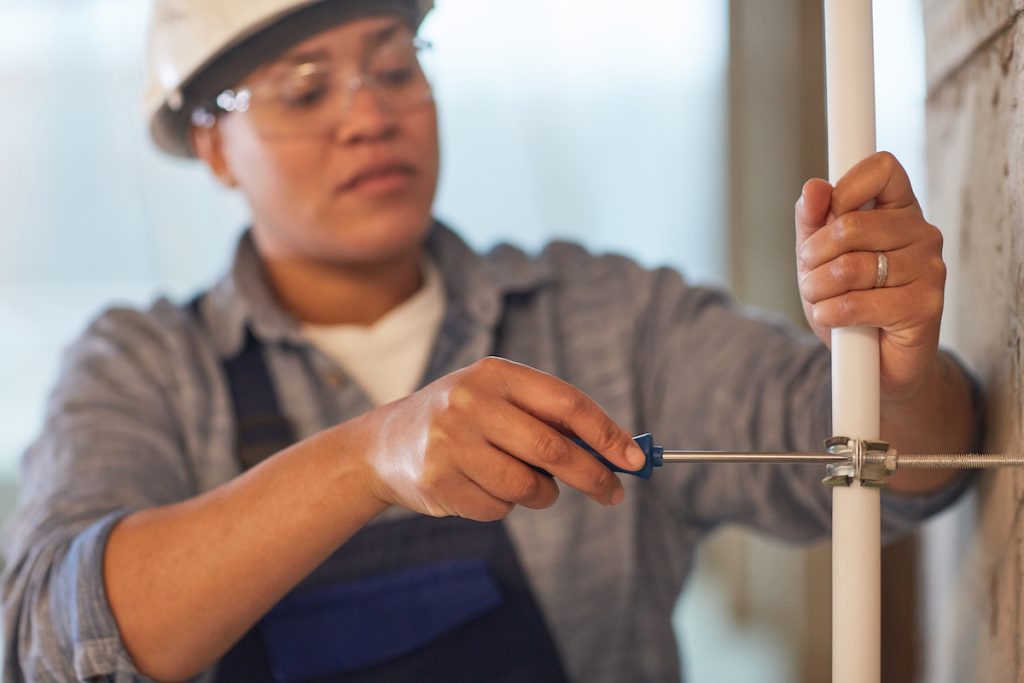Why the Trade Service Industry Needs More Women Plumbers
April 11, 2023 | Read: 10 minutes

Why is it that when we think of plumbers, we almost never imagine women plumbers as the first thing that comes to mind?
Perhaps because women only make up 3.5% of the plumbing workforce… (Zippia.com).
Unfortunately, to most people, this doesn’t come as a surprise because when we think about calling “the plumber,” we typically envision a man.
However, women plumbers do have a fascinating history and it’s becoming a more common choice nowadays. As a business owner or hiring manager for a plumbing company, it’s important to be aware and considerate not simply because it’s the right thing to do, but also because the benefits they bring to the workforce are undeniable.

While there are few female plumbers, the women who are in the trade are forging a path and shaping the future of the industry. Their value and impact in the workspace are clear, but the obstacles presented to them may not be so evident.
From high schools that don’t promote the trades and working with your hands as anything but a last resort to apprenticeships that discriminate, to jobs websites that always advertise using gendered phrases (e.g. “looking for handy guys to join the team”), these are all things that women face when looking to get into the trades.
To better understand, it’s essential to know the background of what the plumbing industry has looked like over the years. So let’s start with a quick crash course:
Women Plumbers: A Brief History
Plumbing itself dates back to ancient Rome, but the modern indoor plumbing we know (and love) today originated in the 19th century–and only became more mainstream in the early 1900s.
While there are plenty of men accredited with the development of plumbing in the United States–Isaiah Rogers, Julius Adams, William Campbell, Fred Addee, Al Moen–the first predominant female name didn’t appear until 1951.
Lillian Baumbach, at the age of 21, was the first woman in the country to receive a master’s license after passing the exam with one of the highest scores in her class. Newspaper articles titled “Pretty Plumber’ Pen Pal of 250 Men,” “Cutest Master Plumber Plans Joint Life with Auto Repairman,” and “Area Now Has Girl Plumber, It Leaks Out” circulated shortly afterward.
Then, in the mid 1960s Comet, a cleaning product company, ran a series of commercials featuring “Josephine the Plumber.” This was one of the first depictions of a woman in a plumbing role, becoming an iconic character for many in the trades.
It wouldn’t be until 1987 that America had its first female African-American master plumber, Adrienne Bennett. And since then, she’s used her experience to become a force in the industry. Now a CEO of her own contracting company, Adrienne mentors men and women while advocating for the trades.
Most recently, there has also been an uptick in the number of women plumbers. According to the Institute for Women’s Policy Research, there was a 70% increase in statistics of the number of women working in plumbing from 2017 (13,200) to 2018 (22,435). Hire a Helper’s article, “What It’s Like To Be a Woman in the Moving Industry in 2022”, also details some modern challenges and the amazing impact women are making in other related industries.
With more young women joining, they have undoubtedly impacted this male-dominated landscape for the better. Which brings us to…
The Benefits of Working with Female Plumbers
A study by the Center for Creative Leadership (CCL) found that having a higher percentage of women in the workplace was positively related to a higher retention rate and better employee engagement.
Plumbing and other trades often suffer from high turnover and difficulty in finding long-term employees, so the following benefits can make a big impact:
Increased job satisfaction
“Culturally, women can give so much to a workforce… they tend to be more nurturing and can change the energy.
It’s funny, on a construction site you don’t really see many men running to other men to tell them about their new baby.
But let me tell you, when I walk by, they know I’m going to be interested. So then they get the opportunity to show off their baby.”
Shannon Tymosko, an apprentice in the trades
More meaningful work
Not only are women plumbers capable and competent for the job, but they’ve also been proven to improve the feeling of doing meaningful work.
What’s more, they can provide services to customers who may not otherwise be comfortable for whatever reason with having men enter their homes.
“We work with women that are survivors of domestic abuse. At a women’s safe house, if some work needs doing and they need to contact a tradesman, it can often be quite stressful for them. We get inundated calls from customers who want to use tradeswomen.”
Hattie Hasan, founder of The Register of Tradeswomen
Less burnout
By including more women in a male-dominated business, it enables workers to be more open and vulnerable. The CCL’s study also found that employees who felt the most support within their organizations were the ones who had the highest percentage of female employees. This created a better overall work environment, increasing satisfaction and retention.
Female plumbers are also essential to a successful plumbing business because they can provide a level of comfort to some customers that male plumbers cannot.

Why don’t businesses hire more women plumbers?
It’s clear having diversity ultimately comes with more benefits than uniformity. So why are some businesses hesitant to hire female plumbers?
Most of it comes down to social norms. Some have the notion that the nature of the job is too dirty, dangerous, or heavy for women. Reality, however, tells a different story.
“Being a plumber is a physical job. As an apprentice, I was only 119 pounds. I’m carrying 20-foot lengths of pipe, steel, and cast iron because there was no PVC. I literally became this Amazon.”
Adrienne Bennett
Given the opportunity, women can easily thrive in the plumbing profession while shaping the industry into a more compassionate one that’s ultimately being enriched by more diverse relationships.
The value of adding a female plumber to your team speaks for itself.
Challenges Women Plumbers Will Face in the Industry
Nevertheless, women in plumbing face numerous obstacles. It’s important to consider these when building your strategy to hire more women. Some of these obstacles are:
Lack of opportunities
A major challenge for women looking to enter the plumbing industry is the lack of opportunities. The World Bank Utility Survey found that water companies hire men over women at a 4-to-1 rate.
And unfortunately, it’s not due to lack of skill. The same study found that there are major gaps in the number of women who graduate from STEM-related fields and those who go on to work in these areas. In Canada, for example, the number is less than 50%.
This suggests that women are more likely to face bottlenecks in the transition from school to employment.
At the same time, Shannon Tymosko highlighted how shortening her name on her resume to the neutral “Shan” significantly increased the number of callbacks she received.
Therefore, it’s essential for plumbing businesses to actively recruit men and women, setting aside stereotypes and misconceptions. If you are struggling to get women to join your company, start reviewing your hiring process.
Check out our plumbing interview questions here!
Male-oriented job descriptions
In male-dominated work cultures, it’s very easy to fall into the trap of phrasing job descriptions that appeal solely to men. Glassdoors gives a few examples of terms that can be a red flag for women such as “bro-speak” or words that emphasize an aggressive drinking or sports-oriented culture. Similarly, including cliche phrases like “work hard, play hard” could be interpreted as a job that requires frequent after-hours drinking, potentially turning off both women and parents or carers.
Research suggests that simply switching out certain words in job postings can change the number of women who apply for the position.
For example, using tradesperson instead of tradesmen. And once you start the interview process, be mindful of the questions you ask as well.
Here’s a great list to get you started.
Few mentorship and networking opportunities
Another challenge female plumbers face is the lack of mentorship and networking opportunities. Since the plumbing field is male-dominated, the majority of these social networks are made up of men. This tends to leave women feeling isolated, even if unintentional.
These connections tend to contribute to professional development, though, making it important as members of the plumbing industry to work towards a far more inclusive environment.
If you own or work for a plumbing company, partner with organizations like Tradeswomen, Inc. to help female plumbers develop their capacity for leadership and career growth.
And if you’re looking to break into the industry as a woman, or need help finding additional resources, consider joining the National Association of Women in Construction. They offer members education, support, and networking to advance their careers.
Advice from Shannon Tymosko
The U.S. Department of Labor states that women make up almost half of the national workforce but represent only 13% of Registered Apprentices. Fortunately, change is coming to the trades. Take Stock! By Commusoft, the trades podcast, published an interesting conversation with Shannon Tymosko, 3rd year electrical apprentice and motivational speaker who speaks on how women and young folks play a critical role in the field service industry.
The episode covers:
- The importance of training new hires and knowledge transfer
- Using social media as a tool to recruit talent
- The value of gender bias training
- How to reach the younger generation
- The significance of representation
Listen to Shannon Tymoskko on our podcast: Take Stock!
The Future of Women Plumbers
The average age of skilled trades is 43, and 27% will retire in the next 10 year.
LEAPROS
This means a significant number of opportunities will open up in the field–for both men and women.
Therefore, now is the time to push for even more gender inclusivity in the plumbing industry. By purposefully hiring and supporting female plumbers the workforce will only benefit. Research has shown that when there are more women in the workplace, these benefits follow:
- People find their work more meaningful
- Male employees find it easier to express their emotions
- Employees are also more engaged and passionate about their trade
Although they make up a much smaller percentage, women have been crushing stereotypes associated with being female plumbers for decades. Starting with Lillian Baumbach who had the highest grades when earning her master’s license to Adrienne Bennett who persevered against all odds, women have proven themselves to be qualified and competent plumbers.
It’s important that the same effort is made by the industry to propel their careers forward, offering women interested in the trades the opportunity for work and professional development.
So, if your plumbing company is looking to hire, seriously consider finding female applicants. If they’re the right fit for your business, the impact they’ll make will be invaluable.

Let’s stay in touch!
Get more valuable articles like this one directly in your inbox!








